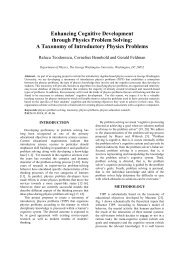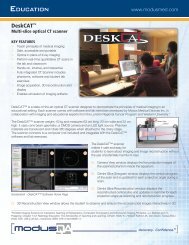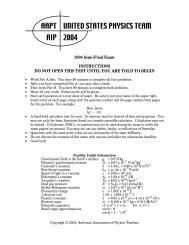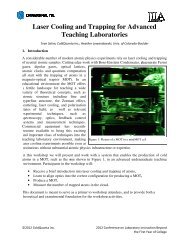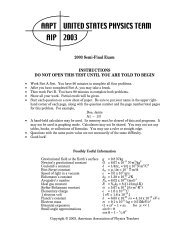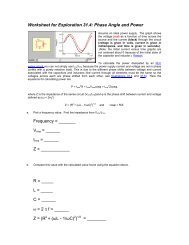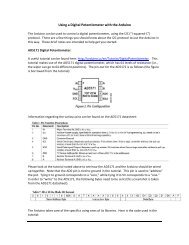thorlabs saturated absorption spectroscopy kit - comPADRE
thorlabs saturated absorption spectroscopy kit - comPADRE
thorlabs saturated absorption spectroscopy kit - comPADRE
You also want an ePaper? Increase the reach of your titles
YUMPU automatically turns print PDFs into web optimized ePapers that Google loves.
THORLABS SATURATED ABSORPTION SPECTROSCOPY KIT<br />
Thorlabs' Teaching Spectroscopy Kit (SKSAS)<br />
Thorlabs SKSAS <strong>spectroscopy</strong> <strong>kit</strong> is an ideal tool for undergraduate teaching labs. The <strong>kit</strong><br />
provides a set of proven components for a fiber‐coupled Saturated Absorption Spectroscopy<br />
setup. It offers a method for producing a highly stable lock for tunable lasers at the peak of<br />
atomic hyperfine structure transitions.<br />
How does it work?<br />
Every atom has a unique set of <strong>absorption</strong> frequencies determined by the hyperfine structure<br />
of the electronic states. If the atoms are at rest, as light is propagated through the system, light<br />
is only absorbed at these discrete transition frequencies, f 0 . At a given temperature, however,<br />
the atoms may be moving according to the Maxwell‐Boltzmann temperature distribution of<br />
velocities. Because of this distribution, some atoms will be stationary, while others will be<br />
moving with various speeds along the direction of light propagation. For laser light at one of the<br />
hyperfine transition peaks, f 0 , the only atoms that will interact are those that are stationary.<br />
Atoms at a speed v can only interact with a laser of frequency f (offset from the transition<br />
frequencies) which satisfies a Doppler shift to a transition frequency f 0 .<br />
Imagine having two counter‐propagating laser beams traveling through a vapor cell. The light<br />
beam at a frequency less than f 0 propagating to the left (right) can only interact with a group of<br />
atoms moving to the right (left). For a laser frequency greater than f 0 , the light can only interact<br />
with atoms moving in the same direction as the beam's propagation. For a particular laser<br />
frequency, each beam interacts with a different group of atoms with a different velocity.<br />
When the laser has a frequency of f 0 , however, both counter‐propagating beams can only<br />
interact with atoms that are at rest. Therefore, there will be a depletion of zero‐velocity ground<br />
state atoms, which will be evidenced by dips in the Doppler‐broadened <strong>absorption</strong> profile.<br />
These dips create very narrow peaks which can be used as a frequency locking point for a<br />
tunable laser.
SAT U R AT E D ABSO R P T IO N SP E C T R O SC O P Y SY ST E MS<br />
O V E R V I E W<br />
Features<br />
Saturated Absorption Spectroscopy for Locking to Atomic<br />
Transitions<br />
Rubidium or Custom Vapor Cell Options<br />
PM FiberCoupled Setup<br />
Ideal for Laser Locking or Teaching Labs<br />
The Thorlabs SKSAS <strong>kit</strong> offers a proven set of components to<br />
construct a compact, fibercoupled Saturated Absorption<br />
Spectroscopy (SAS) setup. It offers a method for producing a<br />
highly stable lock for tunable lasers at the peak of atomic<br />
hyperfine structure transitions. The <strong>kit</strong> also allows for the study of<br />
the hyperfine structure and Doppler broadening of atomic<br />
transitions.<br />
Spectroscopy Systems Selection Guide<br />
Dichroic Atomic Vapor Spectroscopy (DAVS) Systems<br />
Saturated Absorption Spectroscopy (SAS) Systems<br />
Specifications<br />
Required Input Power ~500 µW<br />
Input Fiber Termination*<br />
Detector Bandwidth<br />
Detector Output Range<br />
FC/PC<br />
1 MHz<br />
±10 V<br />
Reference Cell Temperature (Max.) 50 °C<br />
* Alternate fiber inputs are available. Please contact<br />
applications@<strong>thorlabs</strong>.com.<br />
The <strong>kit</strong> has been designed using stock optics and mechanics, as<br />
well as compatible custom components. This makes these <strong>kit</strong>s adaptable using other Thorlabs cage system and lens tube components.<br />
For a list of the major components and subsystems included in the SAS <strong>kit</strong>, please see the Kit Contents tab.<br />
While the vapor cell heater is included in the <strong>kit</strong>, please note that the vapor cell and temperature controller must be purchased<br />
separately. Currently, we offer rubidium reference vapor cells, which are available below. A variety of custom vapor cells are also<br />
available; please contact applications@<strong>thorlabs</strong>.com for more details. Thorlabs' TC200 Temperature Controller is compatible with the cell<br />
heater.<br />
Saturated Absorption Spectroscopy<br />
Saturated Absorption Spectroscopy (SAS) systems provide a means to create a highly sensitive lock tied directly to an atomic transition.<br />
When an atom absorbs (or emits) a photon, the <strong>absorption</strong> (or emission) frequency is Doppler shifted. To create a more narrow laser<br />
lock, Doppler Broadening is eliminated by use of the wellknown <strong>saturated</strong> <strong>absorption</strong> technique that resolves the hyperfine structure of<br />
atomic transitions. For a detailed tutorial on SAS, please see the SA Spectroscopy tab.<br />
Custom Options and Assembly Services<br />
Our <strong>spectroscopy</strong> <strong>kit</strong>s are adaptable to most tunable lasers with usersupplied feedback mechanisms. While our standard <strong>kit</strong> is designed<br />
to accept PM fibercoupled sources, we can also offer <strong>kit</strong>s for freespace input. We can also offer assembly services upon request. To
discuss these and other custom options, please contact us at applications@<strong>thorlabs</strong>.com.<br />
Please note that the Spectroscopy Kits do not come with vapor cells or a temperature controller. Rubidium and Potassium vapor<br />
cells are available below. Thorlabs offers the TC200 temperature controller that is compatible with the gas cell heater provided with<br />
the <strong>kit</strong>.<br />
K I T C O N T E N T S<br />
SAS Kit Contents<br />
Thorlabs' SAS Kits contain the following subsystems:<br />
Fiber Input and HalfWave Plate<br />
Input Prism Assembly<br />
Vapor Cell and Heater<br />
Output Prism Assembly<br />
Pump Mirrors, Folding Mirrors, and Balanced Detector<br />
Fiber Input and HalfWave Plate<br />
The fiber input is designed with our F220FC780 fiber collimator and cage system<br />
components. The collimator collimates the input from an FC/PCterminated PM fiber, which<br />
must be purchased separately. For Rubidium, we recommend using our P1780PMFC5<br />
patch cable. For users who would prefer a freespace input, please contact us at<br />
applications@<strong>thorlabs</strong>.com for a quote for a <strong>kit</strong> without the fiber collimator and mounting<br />
mechanics.<br />
Once the input is collimated, the light passes through a WPMH05M780 halfwave plate. The<br />
wave plate allows the user to vary the relative intensity of the pump and probe beams,<br />
which is helpful during alignment of the <strong>kit</strong>.<br />
Click to Enlarge<br />
Input Prism Assembly<br />
The input prism assembly is constructed on a KM100P kinematic mount using a speciallydesigned<br />
mounting platform accessory. Three prims are then epoxied into place on the<br />
mounting platform: a MRA10M01 rightangle prism mirror, a BS011 50:50 nonpolarizing<br />
beamsplitter, and a PBS102 polarizing beamsplitter.<br />
The polarizing beamsplitter divides the input into the pump and probe beams. The power<br />
into each beam can be adjusted using the halfwave plate (part of the fiber input assembly<br />
described above). The 50:50 nonpolarizing beamsplitter picks off a portion of the input for<br />
a reference beam that measures the direct Dopplerbroadened <strong>absorption</strong> spectrum.<br />
Click to Enlarge<br />
Vapor Cell Heater Assembly<br />
The GCH2575 is provided with the <strong>kit</strong> and is designed to hold Ø9 mm, Ø19 mm, or Ø25<br />
mm vapor cells 75 mm in length. Please note that neither vapor cells nor a temperature<br />
controller for the GCH2575 are included with the SKSAS. Rubidium and Potassium cells<br />
are available on the bottom of this page, and other atomic vapor cells are available upon<br />
request. Thorlabs offers the TC200 temperature controller which is compatible with the<br />
vapor cell heater.<br />
Output Prism Assembly<br />
Click to Enlarge<br />
The output prism assembly is constructed similarly to the input prism assembly, using a custom mounting platform attached to a
KM100P. Three prisms are epoxied to the platform: two MRA10M01 rightangle prism<br />
mirrors, and a PBS102 polarizing beamsplitter.<br />
The polarizing beamsplitter reflects the pump beam to counterpropagate with the probe<br />
beam through the cell. The two rightangle mirror prisms are designed to reflect the probe<br />
and reference beams so that they may be detected using the balanced detector. A diagram<br />
showing the beam path through the system is shown in the "Pump Mirrors, Folding Mirrors,<br />
and Balanced Detector" section below.<br />
Click to Enlarge<br />
Pump Mirrors, Folding Mirrors, and Balanced<br />
Detector<br />
In addition to the input and output prism assemblies, there are four PF05<br />
03M01 Ø1/2" gold mirrors that are mounted in KS05 mounts. Two of<br />
these mirrors are used to direct the pump beam so that it can<br />
counterpropagate with the probe beam and thus create the SAS Dopplerfree<br />
spectrum. The other two mirrors are for directing the probe and<br />
reference beams onto the two photodiodes of the balanced detector. A<br />
beam path diagram is shown to the right, which details the function of<br />
these four mirrors.<br />
The PDB210A Balanced Detector provides three output signals: two are<br />
the signals from each photodiode, and the third is the difference between<br />
these two signals. The voltages from each detector are useful when<br />
aligning the system and to investigate the features of the spectra in<br />
teaching labs, while the difference signal is useful for laser locking.<br />
S A S P E C T R O S C O P Y<br />
Saturated Absorption Spectroscopy<br />
Saturated Absorption Spectroscopy Basics<br />
Every atom has a unique set of <strong>absorption</strong> frequencies determined by the<br />
hyperfine structure of the electronic states. If the atoms are at rest, as<br />
light as propagated through the system, light is only absorbed at these<br />
discrete transition frequencies, f 0 . At a given temperature, however, the<br />
atoms may be moving according to the MaxwellBoltzmann temperature<br />
distribution of velocities. Because of this distribution, some atoms will be<br />
stationary, while others will be moving with various speeds along the<br />
direction of light propagation. For laser light at one of the hyperfine<br />
transition peaks, f 0 , the only atoms that will interact are those that are<br />
stationary. Atoms at a speed v can only interact with a laser of frequency<br />
f (offset from the transition frequencies) which satisfies a Doppler shift to<br />
a transition frequency f 0 . The result for rubidium is a frequency<br />
distribution of <strong>absorption</strong> as shown by the red line in figure 1.<br />
Counter Propagating Beams<br />
One can imagine having two counterpropagating laser beams traveling<br />
through the vapor cell. The light beam at a fequency less than f 0<br />
Figure 1: The Rubidium D2 <strong>absorption</strong> spectrum (red) and<br />
<strong>saturated</strong> <strong>absorption</strong>, or DopplerFree, spectrum (blue).<br />
propagating to the left (right) can only interact with a group of atoms<br />
moving to the right (left). For a laser frequency greater than f 0 , the light can only interact with atoms moving in the same direction as<br />
the beam's propagation. For a particular laser frequency, each beam interacts with a different group of atoms with a different velocity.<br />
When the laser has a frequency of f 0 , however, both counterpropagating beams can only interact with atoms that are at rest.<br />
Therefore, there will be a depletion of zerovelocity ground state atoms, which will be evidenced by dips in the Dopplerbroadened<br />
absorbtion profile, which can be seen in the blue line in figure 1. These dips create very narrow peaks which can be used as a frequency<br />
locking point for a tunable laser.
Figure 2: Schematic diagram of the SAS system.<br />
The SAS System<br />
A schematic of Thorlabs' SAS system is shown in figure 2. Light passes<br />
through a halfwave plate to appropriately set the polarization for the<br />
polarizing beamsplitter cube, which passes 4 µW and reflects 400 µW. The<br />
4 µW beam travels through the cell and passes through the second<br />
polarizing beamsplitter, and is detected by one port of the balanced<br />
detector. This beam is called the probe beam. The 400 µW beam is<br />
redirected by two mirrors to be reflected by the second polarizing<br />
beamsplitter, and travels the cell in the opposite direction of the probe<br />
beam; this is called the pump beam. These counterpropagating pump<br />
and probe beams create the on resonance ground state depletion<br />
described above.<br />
A third reference beam is directed from the reflection of the 50/50<br />
beamsplitter, through the vapor cell, and to the second port of the<br />
balanced detector. By taking the difference of the reference port (direct<br />
transmission) and the probe beam (Dopplerfree transmission) signals<br />
from the balanced detector, a signal like the one in figure 3 is recorded.<br />
This signal removes the Dopplerbroadening to reveal several narrow<br />
peaks. To use these signals for laser frequency stabilization, the laser is<br />
locked to a frequency corresponding to the sharp edge of a transition<br />
peak. There is a voltage V(f 0 ) corresponding to this locking frequency. As<br />
Figure 3: Measurement signal from a balanced detector,<br />
showing the difference between the direct <strong>absorption</strong> and the<br />
dopplerfree <strong>absorption</strong> spectra.<br />
the laser frequency drifts, the voltage of the difference signal will be different, indicated by V(f) on figure 3. An error signal, calculated<br />
by Error(f) = V(f 0 ) = V(f), can then be used by a feedback loop to adjust the lasing frequency until Error(f) = 0. In this manner, the<br />
laser frequency can be locked to the transition.<br />
Visit the Saturated Absorption Spectroscopy Systems page for pricing and availability information:<br />
http://www.<strong>thorlabs</strong>.com/NewGroupPage9.cfm?ObjectGroup_ID=5616




